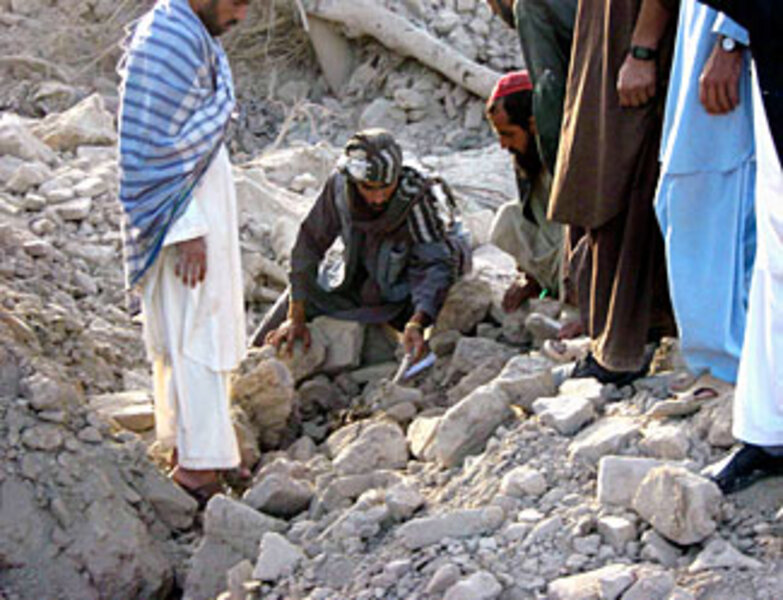WALTER L. HIXSON

A view of the damage at the Zemari Ahmadi family house after a drone strike one day before the final U.S. evacuation flights from Kabul, on Sept. 18, 2021 in Kabul, Afghanistan. Zemari Ahmadi and nine members of his family, including seven children, were reported killed in the airstrike on Aug. 29, 2021. (PHOTO BY BILAL GULER/ANADOLU AGENCY VIA GETTY IMAGES)
Washington Report on Middle East Affairs, November/December 2021, pp. 26-27
History’s Shadows
By Walter L. Hixson
FOR SEVERAL DAYS the American public memorialized the 13 U.S. soldiers killed at the Kabul airport in the Aug. 26 attack, which punctuated the ignominious withdrawal from Afghanistan. It was well and proper that we mourned the deaths of these service men and women, who were carrying out their duties during the chaotic pullout from the latest failed U.S. military intervention abroad.
Amid the photographs, family stories, and saturation coverage of the soldiers’ deaths it was easy to overlook that 169 Afghan civilians also died in the airport terror attack. And on Sept. 17, when after weeks of lies and disinformation, the Pentagon was forced to admit that on Aug. 29, a U.S. drone had unleashed a hellfire missile that killed 10 innocent Afghan civilians—seven of them children—in a “tragic mistake,” it was a one-day story rather than the prolonged media event that the deaths of the 13 U.S. soldiers had precipitated.
The juxtaposition of these tragedies underscores that while Americans mourn deeply over the deaths of their own, they often barely acknowledge and quickly forget “the deaths of others,” as the MIT scholar John Tirman entitled his uncelebrated yet excellent 2011 book on this phenomenon. In Korea, Vietnam and Iraq alone, Tirman recounted, the U.S. military was responsible for the deaths of six to seven million people, the majority of whom were civilians. Before those wars, U.S. indiscriminate bombing killed hundreds of thousands of Japanese and German civilians in World War II.
Exclusive focus on our own casualties and suffering in the wake of events such as the Kabul airport or the Sept. 11, 2001 attacks reinforce notions of American innocence and victimization. However, the United States is anything but an innocent and has been responsible, as Tirman’s book points out, for causing far greater levels of death and destruction than it has suffered in world affairs.
In the “Global War on Terror” (GWOT)—the reckless, unbounded crusade that the United States launched in hysterical reaction to the wrenching 9/11 attacks—hundreds of thousands of people in Afghanistan, Pakistan, Yemen, Libya, Syria, Niger, Somalia and many other venues have been killed compared to a few thousand American deaths. According to Brown University’s Costs of War project, more than 387,000 civilians have been killed in the U.S.-led GWOT. In addition, some 38 million war refugees and displaced persons have been driven from their homes, but we don’t spend night after night on national television discussing these outcomes of the American warfare state. We don’t even talk much about the price tag, which is more than $8 trillion according to the Costs of War project. Yet dare to suggest government spending of comparatively small amounts on public welfare and witness the howls of derision and budget battles that ensue.
MIRRORING THE MILITANT ALLY
So, that’s the society in which we live and every day it comes more and more to resemble another society, that of our “special friend,” the militant little nation of Israel. The United States underwrites Israeli militarism to the tune of $3.8 billion annually and $146 billion since 1948, far more than provided to any other country in the world.
The American largesse has helped the Zionist state carry out its own long history of indiscriminate wars, which in actuality have been massacres. In the early 1980s, Israel’s invasion of Lebanon killed some 20,000 people compared with about 1,200 Israeli dead. The 2008 Operation Cast Lead, a prolonged Israeli massacre in Gaza, killed some 1,400 people, overwhelmingly civilians and including about 350 children. Israel lost about a dozen people, some of them to friendly fire. In 2014 and again in 2021, Israel perpetrated similar asymmetrical slaughters in Gaza, with nary a peep of official U.S. condemnation.
Israel is the world leader in state-sanctioned assassination, with particular emphasis in recent years on targeting Iranians. Before 9/11, the United States officially condemned assassination as an instrument of state policy but the more we identified with Israel, the more we began to mirror and thus to legitimate Israel’s murderous approach. U.S. drone attacks, including several mistaken targets and killings of scores of innocent people like the one on Aug. 29, began under President George W. Bush, and then accelerated dramatically under President Barack Obama, who was highly enamored with drone killing. By the time President Donald Trump approved the U.S. assassination of Iranian militarist Qassim Soleimani in January 2020, U.S. policy was indistinguishable from that of Israel. The similarities extended beyond foreign policy and into domestic policing practices owing to the “deadly exchange” programs in which Israelis train U.S. police departments in the latest tactics of violent repression.
The United States and Israel are not the only nations guilty of indiscriminate killing but clearly they are not innocent victims. While we have every right to mourn our own dead, we also have a moral obligation, one that is widely ignored, to acknowledge the deaths of others—especially when we are the perpetrators of these crimes against humanity.
History’s Shadows, a regular column by contributing editor Walter L. Hixson, seeks to place various aspects of Middle East politics and diplomacy in historical perspective. Hixson is the author of Architects of Repression: How Israel and Its Lobby Put Racism, Violence and Injustice at the Center of US Middle East Policy and Israel’s Armor: The Israel Lobby and the First Generation of the Palestine Conflict (available from Middle East Books and More), along with several other books and journal articles. He has been a professor of history for 36 years, achieving the rank of distinguished professor.



